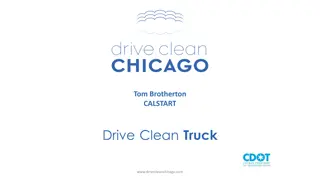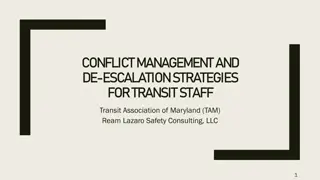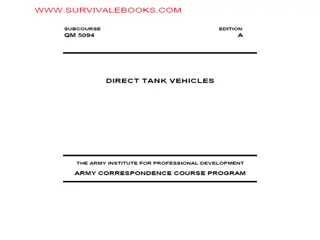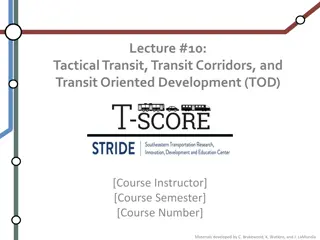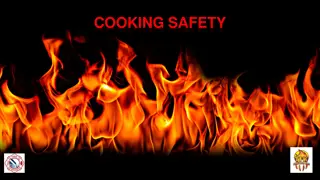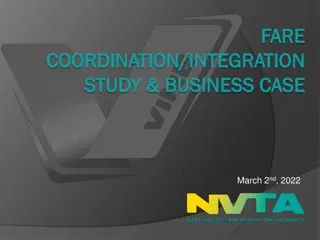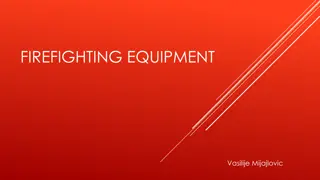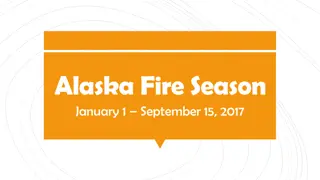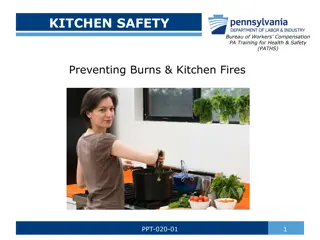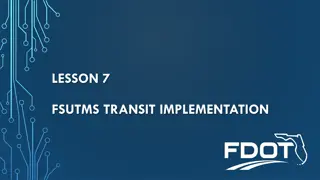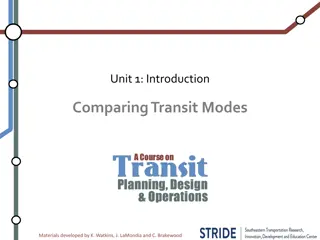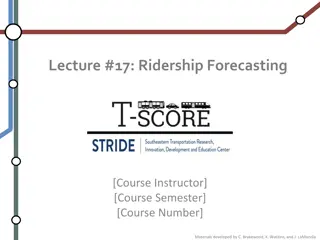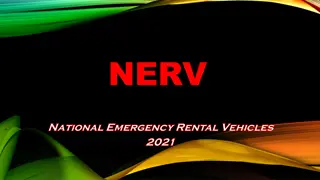Assessing and Mitigating Electrical Fires on Transit Vehicles
The report details a research project on reducing electrical fires in transit vehicles. It includes phases like literature search, identifying causes, making recommendations, and evaluating fire suppression systems. Through document reviews, limited information was found, mostly on vehicle design with better recommendations for railcars. However, maintenance and training suggestions were lacking, highlighting the need for clearer guidance for Transit Agencies.
Download Presentation

Please find below an Image/Link to download the presentation.
The content on the website is provided AS IS for your information and personal use only. It may not be sold, licensed, or shared on other websites without obtaining consent from the author.If you encounter any issues during the download, it is possible that the publisher has removed the file from their server.
You are allowed to download the files provided on this website for personal or commercial use, subject to the condition that they are used lawfully. All files are the property of their respective owners.
The content on the website is provided AS IS for your information and personal use only. It may not be sold, licensed, or shared on other websites without obtaining consent from the author.
E N D
Presentation Transcript
TCRP C-23 Assessing and Mitigating Electrical Fires on Transit Vehicles Report to the Transit Cooperative Research Program September 24, 2020
Project C-23: Identify Recommendations for Reducing the Incidence of Electrical Fires Phase I Task 1: Literature Search Task 2: Identify Primary Causes and Contributing Factors Task 3: Identify Recommendations for Reducing the Incidence of Vehicle Fires Task 4: Identify Additional Research Needs Task 5: Propose Work Plan for Phase 2 Phase II Task 6.1: Study Effectiveness of Current Fire Suppression Systems Task 6.2: Evaluate Fire Suppression Systems for Battery-Electric Vehicles Task 7: Provide Implementation Recommendations
Task 1: Research available documents related to mitigation and prevention of electrical fires Document Database Organization Document Review Field Name Document Title Description The commonly known title of the document including the name or abbreviation of the organization that published the document and its identifying number. The type of organization (Federal or State Agency, SDO or SSOA) that promulgated or published the standard and the name/abbreviation of the issuing entity. Information taken from the documents' abstract, scope, or objective to summarize what the document addresses, establishes or governs and its applicability to design, construction, manufacturing, operations, maintenance, systems, or facilities. Sample Values Database development and document categorization Document Development Agency Type (SOURCE) Government Agency, Standards Organization, Industry Trade Association, etc. Agency outreach Document Description Document Publish Date The release date referenced on the document. Mode Includes transit modes and other modes referenced in the document in which documents may exist that could be beneficial for transit applications. Hierarchical rank of category type. Rail, Bus, Truck, Motorcoach, etc. Document Category Standards, Regulations, Recommended Practices, Research, etc. Operations, SGR, Vehicle, Fire Safety, etc. Document Functional Category Sub-Functional Category This sub-category is intended to categorize documents as outlined in MAP-21 or FAST requirements. Identifies the functional system addressed in the document Electrical, training, fire safety, evacuation, etc. Link A link to the Uniform Resource Locator (URL) address of the individual document or to the Website from which the document can be downloaded.
Task 1: Research available documents related to mitigation and prevention of electrical fires 140 relevant documents reviewed and categorized Document source and transit mode shown below
Task 1: Research available documents related to mitigation and prevention of electrical fires What did we learn: Very limited information, scattered throughout many sources Some generic information dealing with the design of vehicles No maintenance or training recommendations Better recommendations for railcars than buses No clear, concise information available to Transit Agencies Agency Outreach: Team received information from over 50 transit agencies on actual transit vehicle fires: 67 rail vehicle incidents and 164 bus incidents.
Task 2- Based on Task 1 Results, Identify Most Frequent Types of Vehicle Fires Data Analysis from Public Information Limited to non-existent Forced shift in strategy to rely on agency investigations Transit System Feedback Primary source of analysis Large variation in details and experience Agencies recognize the need for additional resources
Task 2- Agency forensic reports used to analyze fire data Actual Causes of Vehicle Fire, based on Agency forensic reports 14 70 Rail Fires Severity and Primary Cause Bus Fire Severity and Primary Cause 12 60 10 50 8 40 Major Minor 6 30 Total Loss 4 20 2 10 0 0 Electrical Exhaust Leak Friction Leak of Fluid Unknown
Task 2- Agency forensic reports used to analyze fire data Perceived Cause of Vehicle Fire, based on Agency Questionnaire Responses
Task 2- Agency Request for additional Guidance Areas of additional Resources Requested In general, agencies rated rail guidance favorably, but bus guidance was rated poorly Specific guidance and information requested on: Research and information needed to identify efficacy of fire suppression systems and its application to rail cars and electric buses Training required to help technicians identify fire risks Best practices & suggestions to share include: Focusing PMI activities on preventing fire hazards Training technicians how to identify fire risks Performing proactive replacement of components to reduce failure induced fires Reviewing cable and harness clamping and securing, using appropriate blocks and brackets
Task 3- Identify Recommendations for Reducing the Incidence of Vehicle Fires Work Plan Agencies self identified maintenance issues as primary concern Fires occurred years after procurement, vehicle design not likely a primary factor Team refocused on PMI and training curriculum guidelines Investigation Team Recommendation to update documents relating to: PM Inspection Guidelines Inspection Process Design Inspector Training
Task 3- Updating PM Inspection Guidelines Successful Preventive Maintenance Programs Tailored to identify and remedy fire risk factors Include predictive maintenance/proactive replacement Include appropriate staff training Agencies developed their own programs Share best practices Agency specific, with baseline standard concepts
Task 3- Updating PM Inspection Process Design Bus and Rail manufacturers provide basis of a PM program Incorporate portion of Australian Standard AS5062 as inspection baseline Modify/Enhance Program to be Agency specific and include: Clamping and securing of power cables Proper routing, including vehicle specific pictures in maintenance documents Insulation condition Predictive/preventive replacements- robust data capture facilitates this
Task 3- Training PM Inspection Staff The PM Program is only successful if qualified staff are performing it Currently, qualifications vary significantly Try to avoid night shift PMIs (often less qualified) or other practices that puts less experienced personnel on PMIs Successful programs demonstrate that it takes 4-6 months of training Pictures are universally touted as excellent training tools- show difference between good vs. bad and progressive damage Vehicle/fleet specific training Classroom training followed by hands-on training with a Qualified Inspector
Task 4- Identify Additional Research Products Based on agency feedback, the team identified key areas that require further investigation Study effectiveness of current fire suppression systems Most agencies now require fire suppression on new buses, but are they effective? Are nozzle locations optimized? Are the chemical agents appropriate for the types of fires? Research the viability of fire suppression for battery electric buses Current trends suggest same type of fire suppression is being installed on battery buses as on diesel buses, is this wise? How should batteries be isolated in event of fire? What is the international experience?
Task 5- Develop Work Plan for Phase II Two critical research needs identified Task 6.1 Evaluation of effectiveness of current fire suppression systems Task 6.2 Research on fire suppression systems for battery buses and electric rail transit vehicles
Task 6.1- Work Plan to study effectiveness of current fire suppression systems Survey bus transit systems who currently use fire suppression systems Gather data about the type and use of fire suppression systems, including any recent reports of fires on buses equipped with fire suppression systems. Evaluate the maintenance programs being used by these properties for their fire suppression systems, including cost if possible. Collect information into data base to perform a value analysis of the installation of fire suppression systems on buses. We will also attempt to perform a comparative analysis into the types of suppression agents used and the size and placement of system components
Task 6.2- Work Plan to study fire suppression systems for battery buses and electric rail vehicles Research available fire suppression systems specifically designed for electric fires Contact the various vendors of vehicle fire suppression systems to collect any test data they have on electric vehicles equipped with their systems. Research information on installations inside and outside of North America. Contact electric bus and rail car builders to get their opinions on fire suppression systems. Try to answer why many light rail and heavy rail cars are not presently being equipped with fire suppression systems. Determine what type of system is most effective for electric vehicles and how the manufacturers isolate power when fires occur. Goal is to develop recommendations for transit systems to use when specifying fire suppression systems for their new all-electric buses and electric rail cars.
Task 7- Implementation of Research Findings and Products Upon completion of the research studies (Task 6): Prepared technical memorandum with recommendations on how to put findings into practice. Identified organizations and/or committees to promote implementation of findings Identified potential hurdles and generate potential solutions to implementation. The team recommended transit vehicle related committees to take leadership roles in advancing the implementation of research findings







